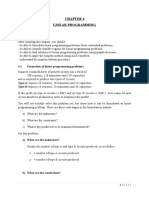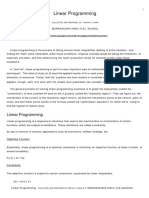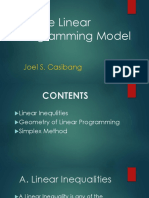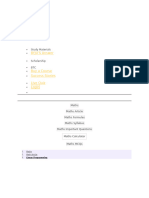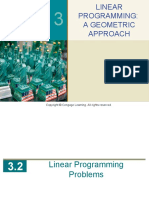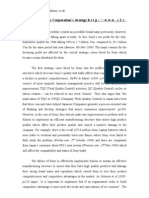Chapter 5 - Linear Programming
Uploaded by
Khabib moginiChapter 5 - Linear Programming
Uploaded by
Khabib moginiChapter 5 Linear Programming MAT1215 Fundamentals of Mathematics
Chapter 5
LINEAR PROGRAMMING
Learning Outcome:
Solve problems involving inequalities and linear programming.
5.1 Graphing Systems of Linear Inequalities in Two Variables
1. A line divides a plane into three sets of points: the points of the line itself and the points
belonging to the two regions determined by the line. Each of these two regions is called a half-
plane. The line is called the boundary.
2. Graphing Linear Inequalities
Step 1: Graph the equation obtained for the given inequality by replacing the inequality
sign with an equal sign. Use a dashed/dotted line if the problem involves a strict
inequality, < or >. Otherwise use a solid line, indicating that the line itself
constitutes part of the solution.
Step 2: Pick a test point (the origin, if possible) lying in one of the half planes
determined by the line and substitute the values of x and y into the given
inequality.
Step 3: If the inequality is satisfied, shade the half plane containing the test point.
Otherwise, shade the other half plane.
Example 1
Graph the solution set for each of the inequality.
(a) 3x + 2y ≥ 6
By TCY & NCX 1
Chapter 5 Linear Programming MAT1215 Fundamentals of Mathematics
(b) x ≤ -2
(c) 3x – 2y > 0
By TCY & NCX 2
Chapter 5 Linear Programming MAT1215 Fundamentals of Mathematics
5.2 Graphing Systems of Linear Inequalities
1. The solution set of a system of inequalities is the intersection of the solution sets of its
members. Graph all solution sets on the same coordinate axes and identify, by shading, the
region common to all graphs.
Example 2
Graph the solution set of the following systems.
(a) 4x + 3y < 12, y + 4x > -4
(b) x + y ≥ 2, 2x - y ≤ 4
By TCY & NCX 3
Chapter 5 Linear Programming MAT1215 Fundamentals of Mathematics
(c) x + y ≥ 3, 2x + y ≥ 4, x ≥ 0, y≥0
5.3 Linear Programming : A Geometric Approach
1. Linear programming was developed during World War II. It was used to allocate supplies for
the U.S. Air Force. Linear programming is used to optimize values subject to certain
constraints. For example, you may want to maximize profit but you are restricted in how many
hours a day you can run a machine or the number of employees you can hire.
2. A linear programming problem consists of a linear objective function to be maximized or
minimized subject to certain constraints in the form of linear equations or inequalities.
3. Graphical Solution of Linear Programming Problems
If a system of linear inequalities defines a bounded planar region, then each point in the region
is a candidate for the solution of the problem and is referred to as a feasible solution. The set
of points in the bounded region is referred to as a feasible set. The feasible solution that
optimizes the objective function is called an optimal solution and constitutes the solution to
the linear programming problem.
4. Theorem 1:
If a linear programming problem has a solution, then it must occur at a vertex, or corner point,
of the feasible set S associated with the problem. Furthermore, if the objective function P is
optimized at two adjacent vertices of S, then it is optimized at every point on the line segment
joining these vertices, in which case there are infinitely many solutions to the problem.
5. Theorem 2:
Suppose we are given a linear programming problem with a feasible set S and an objective
function P = ax + by.
(a) If S is bounded, then P has both a maximum and a minimum value on S.
(b) If S is unbounded and both a and b are nonnegative, then P has a minimum value on S
provided that the constraints defining S include the inequalities x ≥ 0 and y ≥ 0.
(c) If S is the empty set, then the linear programming problem has no solution; that is, P
has neither a maximum nor a minimum value.
By TCY & NCX 4
Chapter 5 Linear Programming MAT1215 Fundamentals of Mathematics
6. The Method of Corners
Step 1: Graph each of the constraints and shade the feasible region.
Step 2: Identify all vertices or corner points.
Step 3: Find the value of the objective function at each vertex.
Step 4: Find the vertex that renders the objective function a maximum (minimum). If there is
only one such vertex, then this vertex constitutes a unique solution to the problem. If the
objective function is maximized (minimized) at two adjacent corner points of S, there are
infinitely many optimal solutions given by the points on the line segment determined by these
two vertices.
Example 1
(a) Maximize P = 3x + 2y
Subject to 2x + 3y ≤ 12, 2x + y ≤ 8, x ≥ 0, y≥0
(b) Maximize: P = x + 2y
Subject to x + y ≤ 4, 2x + y ≤ 5, x ≥ 0, y≥0
By TCY & NCX 5
Chapter 5 Linear Programming MAT1215 Fundamentals of Mathematics
(c) Minimize C = 6x + 8y
Subject to 40x + 10y ≥ 2400, 10x + 15y ≥ 2100, 5x + 15y ≥ 1500. x ≥ 0, y≥0
(d) Find the maximum and minimum of P = 2x + y subject to the following system of linear
inequalities.
2x + 3y ≤ 30, x + y ≤ 4, 2x + y 5, x ≥ 0, y ≥ 0
By TCY & NCX 6
Chapter 5 Linear Programming MAT1215 Fundamentals of Mathematics
Example 4
A manufacturer wishes to produce two types of souvenirs: type-A and type-B. Each type-A souvenir
will result in a profit of RM 1, and each type-B souvenir will result in a profit of RM 1.20. To
manufacture a type-A souvenir requires 2 minutes on machine I and 1 minute on machine II. To
manufacture a type-B souvenir requires 1 minute on machine I and 3 minutes on machine II. There are
3 hours available on machine I and 5 hours available on machine II for processing the order.
(a) Write down two inequalities other than x 0 and y 0 which satisfy the above conditions.
(b) Draw the graph for the two inequalities. Hence shade the region R which satisfies the above
conditions.
(c) List out all the vertices of the feasible set.
(d) Using your graph, find out how many souvenirs of each type should the manufacturer make in
order to maximize profit? What is the maximum profit?
By TCY & NCX 7
Chapter 5 Linear Programming MAT1215 Fundamentals of Mathematics
Example 5
A tourist agency offers a special packaged to town A. The package tour is limited to only 40 members
at a price of RM 100 for an adult, and half price for children below 12 years of age. To ensure
profitability, the agency fixes the ratio of number of children to the number of adults to be not more
than 1:2, and the total collection of payment from all the tourists must be at least RM 3000. Assume
that there are x children and y adults joining the packaged tour.
(a) Write down three inequalities other than x 0 and y 0 which satisfy the above conditions.
(b) Draw the graph for the three inequalities. Hence shade the region R which satisfies the above
conditions.
(c) Using your graph, find the minimum number of adults that can join the packaged tour.
(d) Using your graph, find the minimum profit obtained if the profits obtained for an adult and a
child are RM 80 and RM 20 respectively.
By TCY & NCX 8
You might also like
- Maths Xii Chapter 12 Linear ProgrammingNo ratings yetMaths Xii Chapter 12 Linear Programming39 pages
- Graphical Solution of Linear Programming ProblemsNo ratings yetGraphical Solution of Linear Programming Problems2 pages
- 03 03 Linear Programming Graphic SolutionsNo ratings yet03 03 Linear Programming Graphic Solutions29 pages
- Lesson - Linear Programming - An IntroductionNo ratings yetLesson - Linear Programming - An Introduction26 pages
- LPP INTRODUCTION DEFINITIONAND EXAMPLES OF Linear Programming IntroNo ratings yetLPP INTRODUCTION DEFINITIONAND EXAMPLES OF Linear Programming Intro18 pages
- Simple Linear Programming Model: Joel S. CasibangNo ratings yetSimple Linear Programming Model: Joel S. Casibang49 pages
- Module (17) - Mathematics in The Modern World100% (1)Module (17) - Mathematics in The Modern World8 pages
- Linear Programming Chapter - 12 (Class XII)No ratings yetLinear Programming Chapter - 12 (Class XII)44 pages
- Unit 2 Module 1 Notes - Linear ProgrammingNo ratings yetUnit 2 Module 1 Notes - Linear Programming17 pages
- Linear Programming - The Graphical MethodNo ratings yetLinear Programming - The Graphical Method6 pages
- Chapter 3 - Deriving Solutions From A Linedeear Optimization Model PDFNo ratings yetChapter 3 - Deriving Solutions From A Linedeear Optimization Model PDF40 pages
- Line Drawing Algorithm: Mastering Techniques for Precision Image RenderingFrom EverandLine Drawing Algorithm: Mastering Techniques for Precision Image RenderingNo ratings yet
- CLIL Readers 2 Where Do You Live ResourcesNo ratings yetCLIL Readers 2 Where Do You Live Resources8 pages
- A-Comparative-Study-on-Machine-Learning-Algorithms-for-Smart-Manufacturing-Tool-Wear-Prediction-Using-Random-ForestsNo ratings yetA-Comparative-Study-on-Machine-Learning-Algorithms-for-Smart-Manufacturing-Tool-Wear-Prediction-Using-Random-Forests9 pages
- Present Simple Vocabulary Complete Each Phrase 1-8 With The Words From The BoxNo ratings yetPresent Simple Vocabulary Complete Each Phrase 1-8 With The Words From The Box3 pages
- PAFP Souvenir Prog 2025_2025Feb3CombinedV2No ratings yetPAFP Souvenir Prog 2025_2025Feb3CombinedV2145 pages
- Teacher Candidate Evaluation Form: This Information Is Confidential and Is Not For Public DistributionNo ratings yetTeacher Candidate Evaluation Form: This Information Is Confidential and Is Not For Public Distribution10 pages
- Colegio de San Juan de Letran: College of Liberal Arts and SciencesNo ratings yetColegio de San Juan de Letran: College of Liberal Arts and Sciences2 pages
- Bsc Computer Science Cs Semester 6 2022 April Operating Systems II 2019 PatternNo ratings yetBsc Computer Science Cs Semester 6 2022 April Operating Systems II 2019 Pattern2 pages
- AGU Word Manuscript Template: Immediately For Shortening. Some Journals Have PublicationNo ratings yetAGU Word Manuscript Template: Immediately For Shortening. Some Journals Have Publication5 pages
- Full download Beyond Spacetime The Foundations of Quantum Gravity 1st Edition Nick Huggett (Editor) pdf docx100% (3)Full download Beyond Spacetime The Foundations of Quantum Gravity 1st Edition Nick Huggett (Editor) pdf docx65 pages
- Form 31 Retaking Subjects Taking Unqualified SubjectsNo ratings yetForm 31 Retaking Subjects Taking Unqualified Subjects2 pages
- Evaluation of Sony Corporation's Strategy H T T P: / / W W W - C 2 C - Chat - T KNo ratings yetEvaluation of Sony Corporation's Strategy H T T P: / / W W W - C 2 C - Chat - T K10 pages



